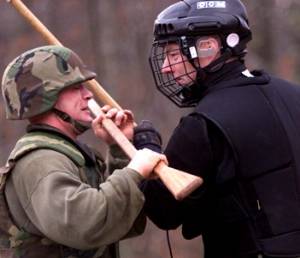
Staff Sgt. Dema Lege (left) and Maj. Kelly Heatherman practice unarmed strikes at Marine Corps Base Quantico, Va. The exercise was Feb. 6, 2001. Photo courtesy U.S. Marine Corps.

By Gerry J. Gilmore
American Forces Press Service
WASHINGTON, May 16, 2001 -- The Marine Corps and the Army - America's land combat forces -- are the leaders among the services in teaching troops hand-to-hand combat and martial arts skills.
Marine Corps Commandant Gen. James Jones last year set a goal that all Marines would receive training in entry-level martial arts skills and be given the opportunity to achieve higher levels of expertise. On March 20, Jones presented tan belts to the first officer basic school graduates to complete initial martial arts training at Marine Corps Base Quantico, Va.
Eventually, "all Marines, regardless of age, sex, rank or job will do this training," said Lt. Col. George H. Bristol, director of the Marines' martial arts program at the Combat Development Center at Quantico. The program, evolved from a May 2000 test study, "is designed to further develop the complete warrior that has always been the United States Marine Corps," he said.
Marines' martial arts training features "a blend of proven disciplines including judo, karate and jujitsu, and bayonet and knife-fighting techniques," said 1st Lt. Jesse L. Sjoberg, Bristol's deputy.

Sgt. Byron Bell (left) and Sgt. Kevin Murphy tangle with their wooden
rifles during bayonet training.
Marine Corps Base Quantico, Va. The exercise was Feb. 6, 2001. Photo
courtesy U.S. Marine Corps.
Bristol, who has 35 years of martial arts experience, said the training is necessary because of changing world events.
"Right now, the world environment is more uncertain than it has ever been," he said. "Within a few days, a situation can escalate from humanitarian missions to full-scale combat." Bristol said the martial arts program integrates three warrior disciplines:

Capt. Sekou Karega closes in with a wooden rifle during bayonet
training.
Marine Corps Base Quantico, Va. The exercise was Feb. 6, 2001. Photo
courtesy U.S. Marine Corps.
The program develops confidence not only in individual Marine combat skills, Bristol said, "but also in the skills of your fellow Marines," because battlefield combat requires teamwork. Marines who learn lethal combat skills are expected -- and required -- to use them responsibly, he said.
"The program teaches the ability to kill, but it is also tightly balanced with ethics," Bristol said, as part of the Corps' definition of a warrior.
"A Marine (is) highly skilled in lethal technique who can function appropriately in any environment. That includes the battlefield to his or her place as a citizen in society," he said.
Army recruits en route to become infantrymen at Fort Benning, Ga., get 15 hours of hand-to-hand combat instruction over 14 weeks as part of the infantry's One Station Unit Training program, said installation spokesperson Elsie Jackson. Troops attending the post's elite Ranger School receive an additional 18 hours of hand-to-hand combative training, including boxing, she added.
Army Special Forces students at Fort Bragg, N.C., receive extensive hand-to-hand combat training, said Carol P. Darby, spokesperson for U.S. Army Special Operations Command at Fort Bragg.
"Over a period of about one year, students in the Special Forces qualification course receive about 30 to 40 hours of combative training," Darby said. This training, she added, begins with basic hand-to-hand moves and advances as students progress through the qualification course.

U.S. Army military police at Fort Benning, Ga., practice hand-to-hand
combat techniques.
Photo courtesy U.S. Army.
After troops graduate from initial Special Forces training and are assigned to their operational groups, they undergo more specialized hand-to-hand combative training, tailored to the mission needs of each unit, said Maj. Jonathan B. Withington, spokesman for U.S. Army Special Forces Command at Fort Bragg.
The Navy and Air Force also provide hand-to-hand and martial arts training, but normally only for members of special operations and law enforcement units. Air Force and Navy recruits don't receive bayonet or hand-to-hand combat training, according to service officials.
Nicewarner, Christian L. "The Marine Martial Arts Program and the Training of One Rifle Company," Marine Corps Gazette, 85:12 (Dec. 2001), 14-17.
Also see: http://www.govexec.com/dailyfed/0102/010402nj2.htm